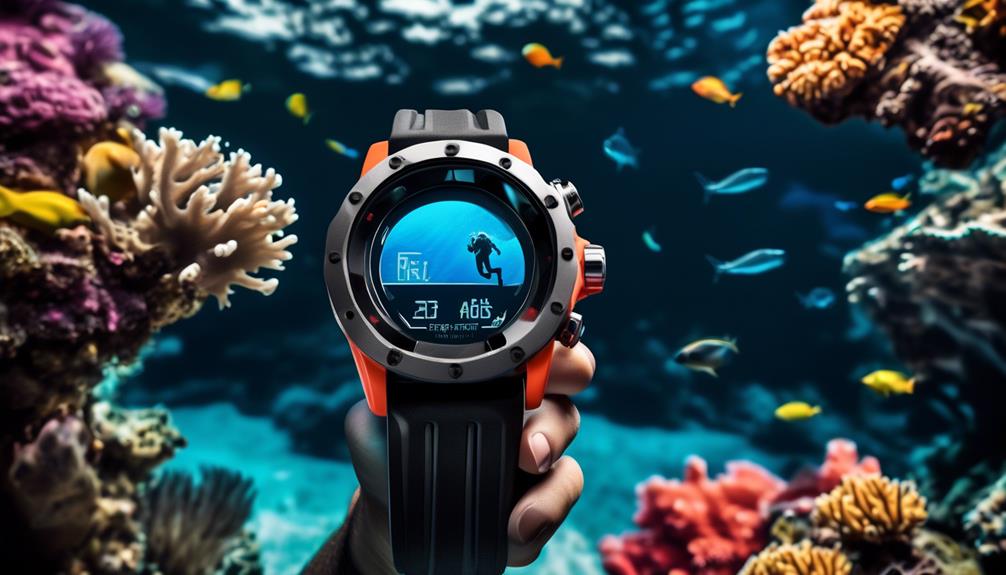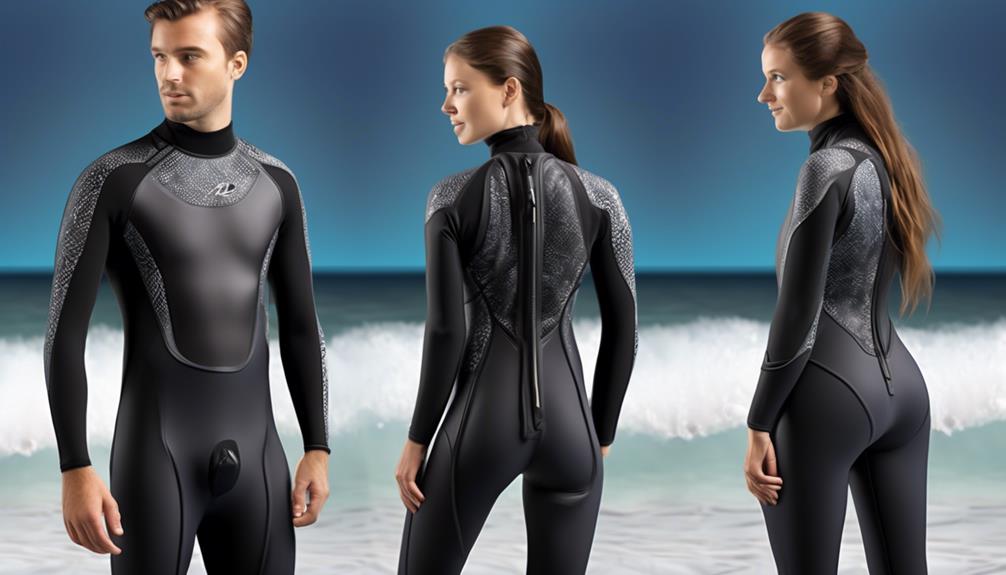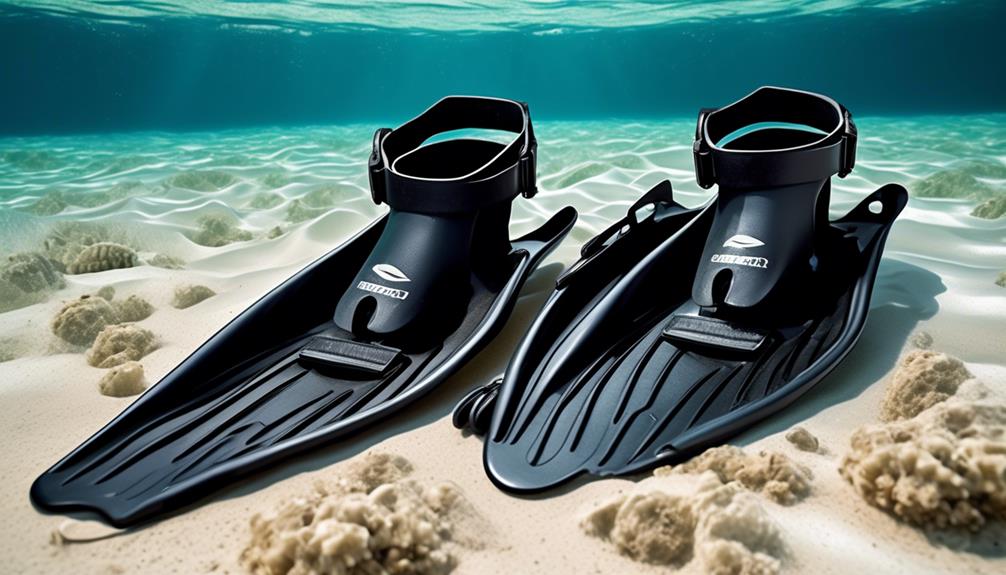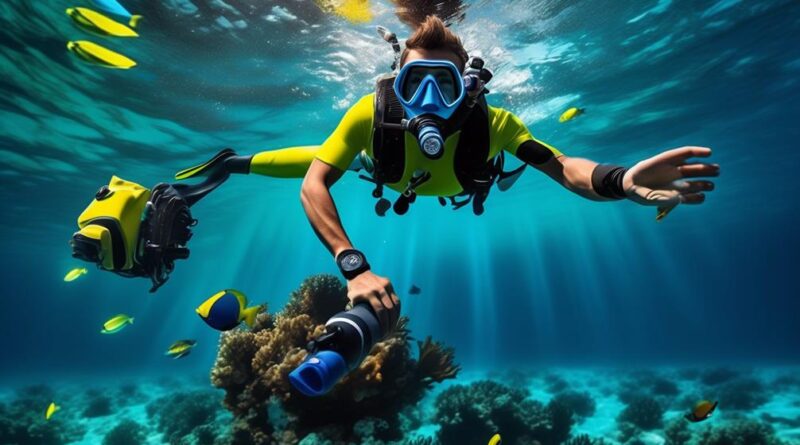Exploring Top-Rated Underwater Diving Safety Gear
When it comes to underwater diving, safety should always be your top priority.
Imagine being able to explore the mesmerizing depths of the ocean with confidence, knowing that you have the best gear to keep you secure.
What exactly makes diving gear top-rated? What features and technologies should you look for to ensure your safety during each dive?
Let's unravel the mysteries of top-rated underwater diving safety gear together, so you can make informed decisions and dive with peace of mind.
Diving Masks
When choosing a diving mask, ensure it provides a snug fit without causing discomfort or pressure points. The mask should form a comfortable seal around your face to prevent water from seeping in. Look for fog-resistant lenses to ensure clear visibility underwater. These lenses are treated to prevent condensation, providing you with a clear view of the underwater world without the need to constantly clear your mask.
If you wear prescription glasses, consider diving masks that offer prescription options. This allows you to enjoy crystal-clear vision while exploring beneath the waves. Additionally, many diving masks come in a variety of colors, allowing you to choose one that suits your style preferences. Whether you prefer vibrant hues or more subdued tones, there's a color variety to match your personal taste.
To ensure the best diving experience, try on different masks to find one that fits comfortably and provides the features you need. Take the time to adjust the straps to achieve a secure fit without causing undue pressure on your face. With the right diving mask, you can enjoy a clear, comfortable, and safe underwater adventure.
Buoyancy Compensators
Consider selecting a buoyancy compensator that allows for easy adjustment and provides reliable support during your dives. Buoyancy control is a crucial aspect of scuba diving, and a high-quality buoyancy compensator (BC) can greatly enhance your safety and comfort underwater. Look for BCs with intuitive inflation and deflation mechanisms that enable you to maintain precise buoyancy at different depths. Additionally, opt for models that offer integrated weight systems for streamlined diving and enhanced stability.
When choosing a buoyancy compensator, prioritize safety features such as quick-release buckles and easy-to-access oral/power inflators for rapid adjustments. Look for BCs with durable construction and reinforced seams to ensure longevity and reliability. Some BCs also come with integrated emergency signaling devices or reflective panels to enhance visibility in low-light conditions, further bolstering your safety during dives.
Another important consideration when selecting a buoyancy compensator is the fit. Look for models with adjustable straps and customizable harness systems to ensure a snug and comfortable fit. A well-fitted BC won't only enhance your diving experience but also improve your overall safety by minimizing the risk of equipment malfunctions or discomfort during your underwater adventures.
Dive Computers

Ensure you choose a dive computer that suits your diving needs and experience level to enhance your underwater safety and enjoyment. Dive computers have evolved significantly with advancements in technology, offering a range of features to cater to different diving styles and requirements. It's crucial to understand the importance of dive computer training and usage to maximize the benefits and safety they provide.
Here are four key aspects to consider when exploring dive computers:
- Dive Computer Technology Advancements: Dive computers now come equipped with advanced features such as air integration, nitrox compatibility, and customizable displays. These technological advancements provide divers with real-time data and insights, allowing for safer and more informed dives.
- Importance of Dive Computer Training: Proper training on how to use a dive computer is essential for ensuring a diver can effectively interpret the data provided and make informed decisions during a dive. Understanding the functions and readings of a dive computer is crucial for maximizing its benefits and enhancing safety.
- Customization Options: Look for dive computers that offer customization options to tailor settings according to your diving preferences and experience level. This allows you to personalize alarms, displays, and dive modes for a more personalized and efficient diving experience.
- User-Friendly Interface: Opt for dive computers with intuitive interfaces and easy navigation. A user-friendly design can enhance the overall diving experience and reduce the potential for confusion or errors while underwater.
Regulators
As you explore the world of underwater diving safety gear, transitioning from dive computers, you'll find that regulators play a critical role in ensuring a smooth and controlled breathing experience while submerged. Proper usage and maintenance of regulators are essential for a safe and enjoyable diving experience. Before each dive, it's crucial to perform regulator safety checks to ensure that the equipment is functioning correctly. This includes inspecting hoses for any signs of damage, checking the second stage for smooth operation, and verifying that the pressure gauge and alternate air source are in good working condition.
Regulator maintenance should be a routine part of your diving preparations. After each dive, thoroughly rinse the regulators with fresh water to remove any salt or debris that could cause damage or corrosion. It's also important to have your regulators professionally serviced according to the manufacturer's recommendations to ensure that all internal components are functioning properly.
In the event of an emergency, knowing the proper emergency procedures for regulator use is vital. If you encounter a problem with your primary regulator, such as free-flowing air, the ability to switch to your alternate air source can make a critical difference. Practicing and being familiar with these emergency procedures can help you stay calm and in control during unexpected situations underwater.
Wet Suits

When diving in cold water, wearing a wet suit helps to maintain your body temperature and protect you from the elements. Here's a closer look at wet suits to help you make an informed decision:
- Benefits: Wet suits provide thermal insulation, protect from abrasions and stings, and offer buoyancy control, keeping you safe and comfortable in cold waters.
- Materials: Neoprene is the most common material for wet suits due to its insulating properties, flexibility, and durability. Some advanced suits also incorporate breathable and quick-drying fabrics for enhanced comfort.
- Maintenance: Proper care, such as rinsing with fresh water after each use and storing away from direct sunlight, can prolong the life of your wet suit. Following the manufacturer's recommendations for cleaning and maintenance is crucial.
- Sizing and Brands: A well-fitting wet suit is essential for its effectiveness. Various brands offer different sizing charts, so it's important to refer to each brand's specific guidelines. Reading reviews and trying on different brands can help you find the best fit.
When considering wet suits, pricing may vary based on the features, technology, and innovations incorporated. It's important to assess your specific diving needs and the water temperatures you'll encounter to determine the most suitable wet suit for you.
Dry Suits
If you're planning to dive in extremely cold water, a dry suit can offer superior protection and insulation compared to wet suits. The main benefit of a dry suit is that it keeps you dry by preventing water from entering, which provides better insulation against the cold. Unlike wet suits, which allow a thin layer of water to seep in and then use body heat to warm it up, dry suits keep you completely dry, making them ideal for cold water diving.
When it comes to maintenance, dry suits require regular care to ensure their effectiveness and longevity. Proper maintenance includes rinsing the suit with fresh water after each dive to remove salt and other contaminants. Additionally, the seals and zippers should be checked and lubricated as needed to prevent damage and maintain a proper seal. It's also important to store the dry suit properly, away from direct sunlight and heat, to prevent deterioration of the materials.
Another advantage of dry suits is the ability to customize them for a more comfortable and secure fit. Customization options may include adjustable seals at the neck and wrists, as well as a range of sizes to accommodate different body shapes. This customization ensures a better fit, which in turn enhances insulation and overall safety during dives in cold water conditions.
Diving Fins

After ensuring the proper care and maintenance of your dry suit, the next essential piece of underwater diving gear to focus on is the selection of high-quality diving fins. Diving fins play a crucial role in your underwater propulsion and overall diving experience. When choosing the right pair, consider the following factors to ensure optimal performance and comfort:
- Fin Design for Efficient Propulsion: Look for fins with an efficient design that maximizes propulsion with each kick. Split fins are popular for providing a powerful thrust with minimal effort, reducing fatigue and conserving energy during dives. Additionally, consider the length and shape of the fins to ensure they're suitable for the types of dives you frequently undertake.
- Fin Material for Durability: Opt for fins made from durable materials such as high-grade plastic, rubber, or advanced composite materials. These materials offer resilience against impacts, abrasions, and harsh underwater conditions, ensuring that your fins can withstand the rigors of diving over an extended period.
- Comfort and Fit: Prioritize fins that offer a comfortable fit without causing blisters or discomfort. Adjustable straps and ergonomic foot pockets can enhance the overall fit and comfort, allowing you to focus on your underwater exploration without distractions.
- Maneuverability and Control: Consider the maneuverability and control offered by the fins. Look for features that facilitate precise movements and easy maneuvering, especially in tight or challenging underwater environments.
Selecting the right diving fins tailored to your diving style and preferences can significantly enhance your underwater adventures, providing efficient propulsion and comfort for an enjoyable diving experience.
Dive Lights
Consider the importance of selecting reliable and powerful dive lights for enhancing your underwater visibility and safety. When choosing dive lights, one crucial factor to consider is light intensity. Opt for lights with high lumens to ensure maximum visibility in low-light conditions. LED dive lights are a popular choice due to their intense brightness and energy efficiency. Look for lights with adjustable brightness settings to cater to different diving environments and needs. This feature allows you to conserve battery life when high intensity isn't required, extending the overall usage time of the light.
Speaking of battery life, it's imperative to select dive lights with long-lasting battery power. Look for lights with rechargeable lithium-ion batteries, which offer extended usage time and consistent brightness throughout the dive. Additionally, consider dive lights with battery level indicators, allowing you to monitor the remaining power and plan your dives accordingly. Some dive lights also feature overheat protection, ensuring that the battery and light components remain safe during prolonged use at high intensities.
Frequently Asked Questions
Can I Use Regular Swim Goggles Instead of a Diving Mask for Underwater Diving?
You can't use regular swim goggles for diving. Snorkel masks provide better visibility and cover your nose, allowing you to equalize pressure. Proper snorkeling techniques are essential for safety. Always use appropriate gear for diving.
What Should I Do if My Buoyancy Compensator Malfunctions While Underwater?
If your buoyancy compensator malfunctions underwater, stay calm and signal your buddy. Use your alternate inflation system. After surfacing, inspect and maintain your buoyancy compensator regularly to prevent future issues.
How Can I Prevent My Dive Computer From Getting Damaged by Water or Pressure?
To safeguard your dive computer, regularly check seals for wear, and ensure proper closure. Rinse with fresh water after each dive and store in a cool, dry place. Follow manufacturer's guidelines for maintenance and waterproofing techniques.
What Is the Best Way to Clean and Maintain My Diving Regulator?
To clean and maintain your diving regulator, rinse it in fresh water after diving. Use a regulator-specific cleaning solution and soft brush for thorough cleaning. Follow the manufacturer's maintenance schedule for routine servicing to ensure optimal performance and safety.
Can I Wear a Wetsuit for Diving in Colder Water or Do I Need a Specific Dry Suit?
You can wear a wetsuit for diving in colder water, but a drysuit offers better insulation. Both are suited for cold water diving. Proper maintenance of your diving gear ensures safety, while enhancing underwater visibility and buoyancy control.
Conclusion
So, whether you're a beginner or an experienced diver, investing in top-rated underwater diving safety gear is essential for a safe and enjoyable diving experience.
From diving masks to dive lights, there are plenty of options to choose from that can enhance your safety and comfort underwater.
Make sure to do your research and invest in high-quality gear that meets your specific diving needs.
Happy diving!
